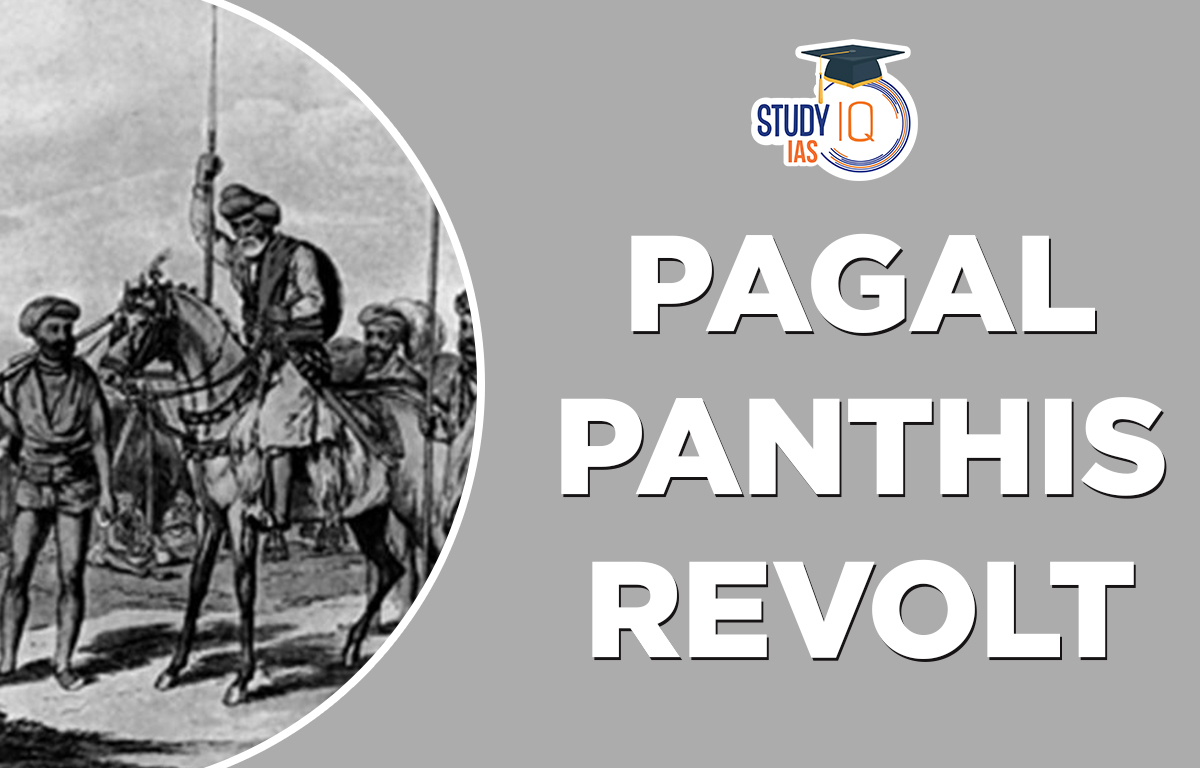Table of Contents
Pagal Panthis
Karim Shah founded the Pagal Panthi, a semi-religious group mainly made up of the Hajong and Garo tribes of the Mymensingh district (previously in Bengal). Under Tipu Shah’s leadership, the movement quickly transformed into a widespread, armed struggle against the British Raj and the zamindar (landlord) system. The order, which followed a syncretic blend of Hinduism, Sufism, and Animism, sought to uphold religious principles and the rights of landless peasants in Bengal. You will learn about The Pagal Panthis (1825) in this article, which will assist with your preparation for the UPSC Civil Service Exam.
Read More: Chuar Uprising
Pagal Panthis History
A religious organisation known as the Pagal Panthis emerged in Bengal’s province’s northern Mymensingh and Sherpur District regions. Contrary to the rest of Bengal, the area was primarily inhabited by animist and indigenous peoples like the Garos, Hajangs, Dalus, and Hodis.
Religious harmony prevailed in the area, which gave religious reform organisations like the Pagal Panthis, an order founded by Karim Shah and other followers of Muslim fakir Majnu Shah, head of the Madariya Sufi order, a forum. After Karim Shah’s passing in 1813, his son Tipu Shah oversaw the organisation.
Read More: Ramosi Uprising
Pagal Panthis Causes
The British East India Company had taken over control of Bengal and ultimately most of India, and Majnu Shah, the patron saint of the Pagal Panthis, was well known for inciting uprisings. Tipu Shah focused his organisation on mobilising peasants in uprisings against the oppressive taxation and regulations imposed by zamindars (landlords) and the British. The fighting between British and Burmese troops had left the area in ruins.
The Company and the landowners imposed harsh taxes on the local peasants to help pay for the war’s expenses. Forced property collection and takeover increased peasant unrest and volatility. The Pagal Panthis made an effort to safeguard and defend peasants from the bands of landowners and the Company’s armed forces. Tipu Shah took control of the community’s political and religious leadership before establishing his rule in the name of Allah and stationing his troops in a mud fort close to Sherpur. People in the area disregarded Tipu Shah’s orders and did not pay British taxation.
Read More: Kuka Movement
Pagal Panthis Impact
In 1813, Karim Shah died. He was replaced in the Pagal Panthis’ gadi (seat) by his son tipu shah, also known as Tipu Pagal. He significantly altered the movement’s personality. It resembled a peasant organisation. To defend the peasants from the zamindars’ oppression and inflated claims, the Pagals and their allies engaged in combat with the zamindars and the company’s troops. In 1833, Tipu Shah and some of his rebellious supporters were apprehended and put on trial. The government reduced the requests of the peasants who were resisting, including the rate of rent. As a result, the movement split, and the region experienced a return to calm.
Following Tipu Shah, Janku Pathor and Dobraj Pathor assumed control of the Pagals and sparked a new uprising against zamindari tyranny. They resisted the government with vigour. They invaded Sherpur town, ransacked the revenue and zamindari offices, and took the weapons from the police station before burning them. The insurgents proclaimed themselves the region’s masters. At Mymensingh, the zamindars, government representatives, and cops sought refuge. It seemed as though the corporate government had vanished for a while. However, by making rent rate concessions to them, peace was ultimately restored.
Read More: Munda Rebellion
Pagal Panthis Aftermath
An armed group of Pagal Panthis led by the Pathors marched into the town of Sherpur, took control of the authorities there, including the police, landowners, and officials, and forced them to flee to Mymensingh. For more than two years, the rebels kept control of the village and the surrounding lands after claiming ownership.
More concessions to the cause of the peasants were made as a result of negotiations and agreements between the rebels and the Brits. The government implemented a fair agreement to protect these peasants, but the movement was severely put down as a result.
Read More: Moplah Rebellion
Pagal Panthis UPSC
The Pagal Panthis were a semi-religious community that was primarily made up of the Hajong and Garo tribes of Mymensingh District (in former Bengal). The Karam Shah established this Pagal Panthi sect. But by the time Tipu Shah succeeded his father Karam Shah as ruler, the tribals had become more solidified. Read all the details related to Pagal Panthis for UPSC Exam Preparations.
Read More: Munda Rebellion


 Jallianwala Bagh Massacre, Date, History...
Jallianwala Bagh Massacre, Date, History...
 Important Lakes of India, State wise and...
Important Lakes of India, State wise and...
 Buddhism History, Origin, Sect, Councils...
Buddhism History, Origin, Sect, Councils...





















